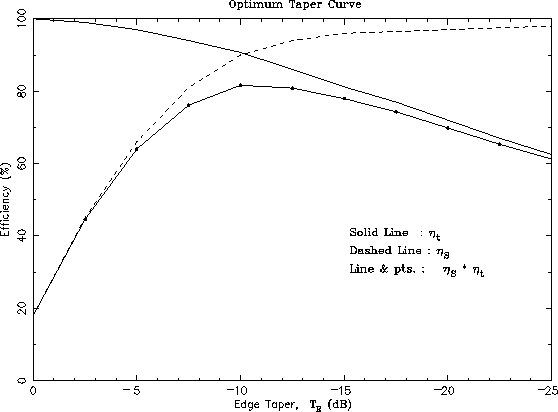The ``aperture efficiency'' of an antenna was earlier defined
(Sec 19.3) to be the ratio of the effective radiating (or
collecting) area of an antenna to the physical area of the antenna.
The aperture efficiency of a feed-and-reflector combination can be
decomposed into five separate components: (i) the illumination efficiency
or ``taper efficiency'', ![]() , (ii) the spillover efficiency,
, (ii) the spillover efficiency,
![]() , (iii) the phase efficiency,
, (iii) the phase efficiency, ![]() , (iv) the crosspolar
efficiency,
, (iv) the crosspolar
efficiency, ![]() and (v) the surface error efficiency
and (v) the surface error efficiency ![]() .
.
| (19.4.10) |
The illumination efficiency (see also Chapter 3, where it
was called simply ``aperture efficiency'') is a measure of the nonuniformity
of the field across the aperture caused by the tapered radiation pattern
(refer Figure 19.2). Essentially
because the illumination is less towards the edges, the effective area
being used is less than the geometric area of the reflector. It is given by
 |
(19.4.11) |
When a feed illuminates the reflector, only a proportion of the
power from the feed will intercept the reflector, the remainder being the
spillover power. This loss of power is quantified by the spillover
efficiency, i.e.
Note that the illumination efficiency and the spillover efficiency
are complementary; as the edge taper increases, the spillover will decrease
(and thus ![]() increases), while the illumination or taper
efficiency
increases), while the illumination or taper
efficiency ![]() decreases19.1 The tradeoff between
decreases19.1 The tradeoff between ![]() and
and
![]() has an optimum solution, as indicated by the product
has an optimum solution, as indicated by the product
![]() *
* ![]() in Figure 19.3. The maximum of
in Figure 19.3. The maximum of
![]() occurs for an edge taper of about -11 dB and has a
value of about 80 %. In practice, a value of -10 dB edge taper is
frequently quoted as being optimum.
occurs for an edge taper of about -11 dB and has a
value of about 80 %. In practice, a value of -10 dB edge taper is
frequently quoted as being optimum.
 |
The surface-error efficiency is independent of the feed's
illumination. It is associated with far-field cancellations arising from
phase errors in the aperture field caused by errors in the reflector's
surface. If ![]() is the rms error in the surface of the reflector,
the surface-error efficiency is given by
is the rms error in the surface of the reflector,
the surface-error efficiency is given by
The remaining two efficiencies, the phase efficiency and the
cross polarization efficiency, are very close to unity; the former
measures the uniformity of the phase across the aperture and the latter
measures the amount of power lost in the cross-polar radiation pattern.
For symmetric feed patterns[6], ![]() is defined thorough
the copolar,
is defined thorough
the copolar,
![]() and cross-polar patterns,
and cross-polar patterns,
![]() :
:
| (19.4.16) | |||
With this background we now proceed to take a detailed look at the GMRT antennas.